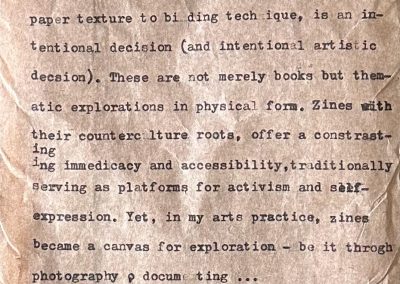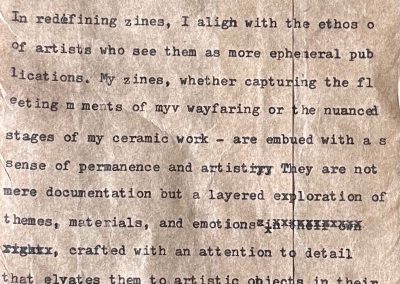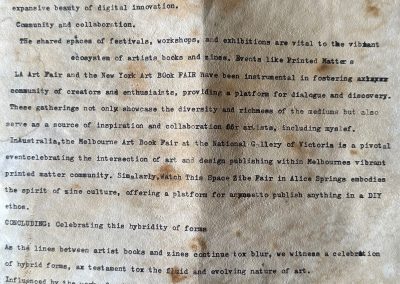In the realm where art transcends traditional mediums, artist books and zines emerge as pivotal expressions of creativity, merging to blur the lines of categorisation. My journey into the confluence of these forms has been both a personal exploration and a broader reflection on their evolving intersection. This narrative is enriched by the pioneering work of artists who have challenged, defined, and redefined what these mediums can be.
The Essence of Artists Books
Artist books, to me, are akin to sculptures; crafted with meticulous care where every element, from paper texture to binding technique, is an intentional artistic decision. These are not merely books but thematic explorations in physical form. Zines, with their countercultural roots, offer a contrasting immediacy and accessibility, traditionally serving as platforms for activism and self-expression. Yet, in my artistic practice, zines become a canvas for exploration – be it through photography, documenting my practice, conceptualising new work … there exists a blurring of the lines between the zine and artists books, a phenomenon Janet Zweig’s 1998 article “Artists, Books and Zines” aptly highlights when she recalls her own transition from the realm of artists books to the vibrant world of zines, recognising the latter’s potent fulfilment of the democratic ideals once envisioned for artist books.
The dialogue between artist books and zines is not new. Artists like Dieter Roth and Johanna Drucker have navigated this space, crafting works that defy easy categorisation. Roth’s artist books, with their experimental form and content, echo the transformative potential I see in zines. Drucker’s scholarly and creative work, exploring the narrative and structural possibilities of books, inspires my thoughtful approach to zine layout and design. Ed Ruscha’s artist books, such as “Twenty-Six Gasoline Stations,” embody simplicity and observational artistry, qualities I strive for in many of my own art-zines. His work demonstrates how the mundane can be elevated to art, a principle that guides my explorations of the everyday through the lens of my practice.
The Guerrilla Girls, through their zines and posters, utilised the immediacy and accessibility of the medium to challenge and subvert, illustrating the power of printed art as a vehicle for social commentary. Their work, though more overtly political than mine, underscores the potential of zines and artist books to be potent tools of expression and activism.
The Artistic Merit of Zines
In redefining zines, I align with the ethos of artists who see them as more than ephemeral publications. My zines – whether capturing the fleeting moments of wayfaring, or the nuanced stages of my ceramic work – are imbued with a sense of permanence and artistry. They are not mere documentation but a layered exploration of themes, materials, and emotions, crafted with an attention to detail that elevates them to artistic objects in their own right. This sentiment resonates with Zweig’s observation that while zines originated from a need for alternative forms of communication, much like artists’ books, they have carved out a unique niche that artists books have struggled to occupy, by maintaining a low threshold for entry and focusing on reaching audiences directly, bypassing traditional commercial avenues.
Experiential Dimensions and Digital Frontiers
The digital age has expanded the possibilities for artist books and zines, a frontier eagerly embraced by contemporary creators. Digital platforms offer new ways to disseminate and experience these works, allowing for interactive and augmented realities that further blur the lines between traditional and new media art forms. In my work, the integration of digital techniques and platforms complements the tactile and physical aspects of zines and artist books, creating a multi-sensory experience that bridges the gap between the artist’s vision and the audience’s perception. Zweig’s examination of the zine movements adaptation to and embrace of a digital platforms underlines a similar narrative within artists books. The transition to digital has not diminished the tactile and intimate nature of these forms but has instead opened new avenues for engagement. Through augmented reality, for instance, an artist book or zine can transcend its physical boundaries, offering layers of interactive content that can be explored beyond the page. Similarly, digital platforms can transform how these works are shared and experienced, making them accessible to wider audiences across the globe. The result is a richer, more immersive experience that combines the best of both worlds: the tangible beauty of traditional mediums and the expansive potential of digital innovation.
This embrace of digital frontiers is emblematic of the broader shifts within the realm of publication arts, where the boundary between artists books and zines continue to blur, field by a shared ethos of accessibility, experimentation, and direct communication with audiences. As we navigate this digital landscape, the core values of artists books and zines remains intact, underscored by a commitment to pushing the boundaries of what these mediums can be and how they connect us to each other and the world around us.
Community and Collaboration
The shared spaces of festivals, workshops, and exhibitions are vital to the vibrant ecosystem of artist books and zines. Events like “Printed Matter’s LA Art Book Fair” and the “New York Art Book Fair” have been instrumental in fostering a community of creators and enthusiasts, providing a platform for dialogue and discovery. These gatherings not only showcase the diversity and richness of the mediums, but also serve as a source of inspiration and collaboration for artists, including myself. In Australia, the “Melbourne Art Book Fair” at the National Gallery of Victoria is a pivotal event, celebrating the intersection of art and design publishing within Melbourne’s vibrant printed matter community. Similarly, “Watch This Space Zine Fair” in Alice Springs embodies the spirit of zine culture, offering a platform for anyone to publish anything in a DIY ethos. Zweig’s reflection on the emergence and vitality of zine culture, with its extensive network of creators and distributors, underscores the strength found in community and collaboration, which is essential in the blurring of lines between artist books and zines. As I reflect on the vibrant communities that have nurtured the growth of artists books and zines, it’s impossible to overlook the foundational texts that continue to shape our understanding of these mediums. Despite its age, Janet Zweig’s “Artists, Books, Zines”, remains a pivotal work, offering deep insights into the motivations, aspirations, and challenges that have driven the evolution of these forms. Zweig’s exploration into the democratising potential of artists books and zines underscores the importance of the mediums as tools for personal expression. activism, and direct engagement with diverse audience.
A Celebration of Hybrid Forms
Zweig’s article, though written years ago (like much scholarly articles on zine culture and artists books) resonates with a timeless relevance that enriches our conversation about the blurring of lines between artists books and zines. Her reflections serve as reminder that the core of artistic innovation lies not merely in the medium itself, but in the persistent reimagining of arts potential to connect, challenge and captivate. As I celebrate the hybrid forms emerging from the intersection of artists books and zines, I acknowledge the enduring influence of thinkers like Zweig, who have laid the groundwork for this on-going dialogue.
As the lines between artist books and zines continue to blur, I witness this as a celebration of hybrid forms, a testament to the fluid and evolving nature of art. Influenced by the work of artists who have traversed these boundaries, my own practice seeks to explore the intersections of form, content, and materiality. This journey, though deeply personal, is part of a larger dialogue – a dialogue that challenges our perceptions, encourages experimentation, and ultimately enriches our understanding and appreciation of the multifaceted world of artist books and zines.
Bibliography
Sandhu, M. (2020). Artist Books and Art Zines: Past and Present. Chitrolekha Journal on Art and Design, 4(2). https://doi.org/10.21659/cjad.42.v4n201
Tauba Auerbach https://taubaauerbach.com/other.php
Auerbach’s work straddles the boundary between various mediums, including painting, printmaking, photography, and book design, making her an interesting artist to research in relation to the subject matter of this post.
Dieter Roth – Inventor of the Artist Book
https://www.theartstory.org/artist/roth-dieter/
Johanna Drucker Artists Books https://www.johannadrucker.net/books.ht
Zweig, J. (1998). Artists, Books, Zines. Afterimage, 26(1), 4–5. https://doi.org/10.1525/aft.1998.26.1.4




Very interesting subject, appreciate it for putting
up.Raise range